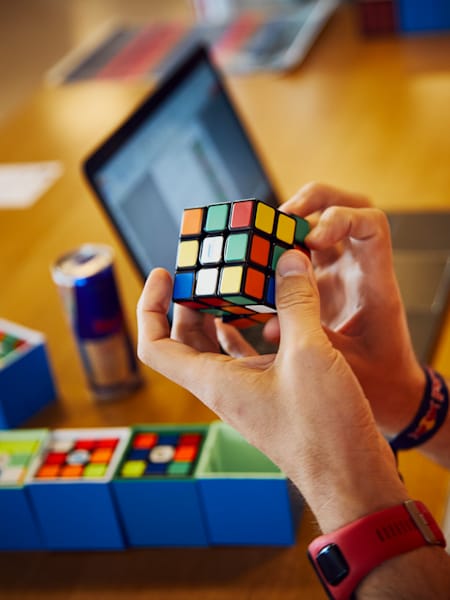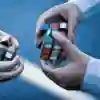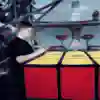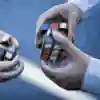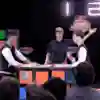The stage is set for the first ever all-digital Red Bull Rubik’s Cube World Cup. More than 2,000 hopefuls have been whittled down to the world’s 30 fastest cubers ahead of November’s virtual final.
While in previous tournaments, competitors have travelled to Paris, Boston and Moscow, this year’s edition is completely online – finalists won’t even have to leave their homes to take part.
Instead, they will be equipped with an innovative, fully digital Rubik’s Connected Cube, which tracks players’ turns and solves via an app.
There have already been some incredible times recorded with the Connected Cube in the World Cup qualifying events – in Digital Qualifier 1, Canada’s Bill Wang registered the fastest-ever competitive single solve on the new cube, with a lightning quick time of 5.246s.
How does solving a Connected Cube differ from a real one? In short, the algorithms and steps to solving the cube remains exactly the same. However, the app provides detailed animations, videos and steps to solving the cube for beginners. Below is all the information you’ll need to take on the world’s best from the comfort of your own home.
But first, as the name suggests, the Connected Cube needs something to connect to, so download the companion app [from Google Play or the App Store] which will enable you to link your phone or tablet to the cube to get you up and running.
Step 1 – Scramble
The app will guide you through scrambling your cube to a competition standard degree of difficulty. Follow the instructions and you’ll be ready to start solving.
There’s a degree of luck here, as there are definitely easier and harder scrambles to solve. However, rest assured that if you’re going head-to-head with someone else, they’ll have the exact same scramble as you.
Step 2 – Learn the algorithms
In the four digital qualifying events for November’s Red Bull World Cup Final, solve times exceeded all expectations. If you ask any speedcuber how they learned to solve the cube, most will give you the same answer – online tutorials.
For a comprehensive step-by-step video guide, see these steps to becoming a Rubik’s Cube master. But for beginners, here’s a very quick and basic overview of the seven steps the app will guide you through.
A white cross:
To create the white cross, you first need to arrange all the white middle pieces around the yellow centre to create a ‘daisy’.
Solve the white corners:
Having achieved the cross, now the goal is to fill in the white corners for a whole white side.
Solve the middle edges:
The goal of this step is to end up with the bottom two rows of your cube complete. Top tip, the four ‘edge’ pieces in the top layer with no yellow are the key to solving this part of the puzzle.
Make a yellow cross:
Once these edges are in place, you’ll need to create another cross, this time a yellow one on the top layer. There are a number of ways to do this and the app will guide you through the easiest options available to you.
Position the yellow corners:
Next up, you'll need to position the remaining four yellow corners. At the end of this step, your edges will be in the correct place, but not yet oriented correctly.
Orient the corners:
The penultimate step before solving the cube is to rotate your yellow corners until all are correctly oriented in relation to the other colours. You should be left with an almost perfect cube, barring a couple of misplaced yellow edges.
The final face:
The final step before solving the cube is to align the final yellow edges. There is no shortcut here folks, there is a fairly lengthy algorithm that you just have to learn.
Step 3 – Improve
One of the huge benefits of the Connected Cube is that all your solves are tracked and logged. This means you can analyse every solve you’ve attempted and work out how to go faster with fewer moves next time.
While the digital cube allows you to compete against others through the app, when solving a Rubik’s Cube, it’s important to remember you're only ever really competing against yourself.
Red Bull Rubik’s Cube World Cup UK finalist Chris Mills is a big fan of this feature. He explained: “It’s so handy to be able to look back on your solves, see your solutions and your move count, without spending loads of time trying to figure it out or manually type your results into a computer.”
Step 4 – Compete
Because the cube is completely digital, it opens up a whole world of possibilities.
Cubers can compete with players across the globe, challenge each other to live battles and attempt to rise up the international leaderboard by posting faster and faster times.
Finalists for next month’s Red Bull Rubik's Cube World Cup are already using the feature to take each other on in order to gain some competitive practice that wouldn’t be possible with a regular cube.
Chris added: “I absolutely love the race feature – George [Scholey] and I have used it loads. Hopefully, having that element of competition means we’ll feel more confident and prepared when cubing in actual tournaments.

